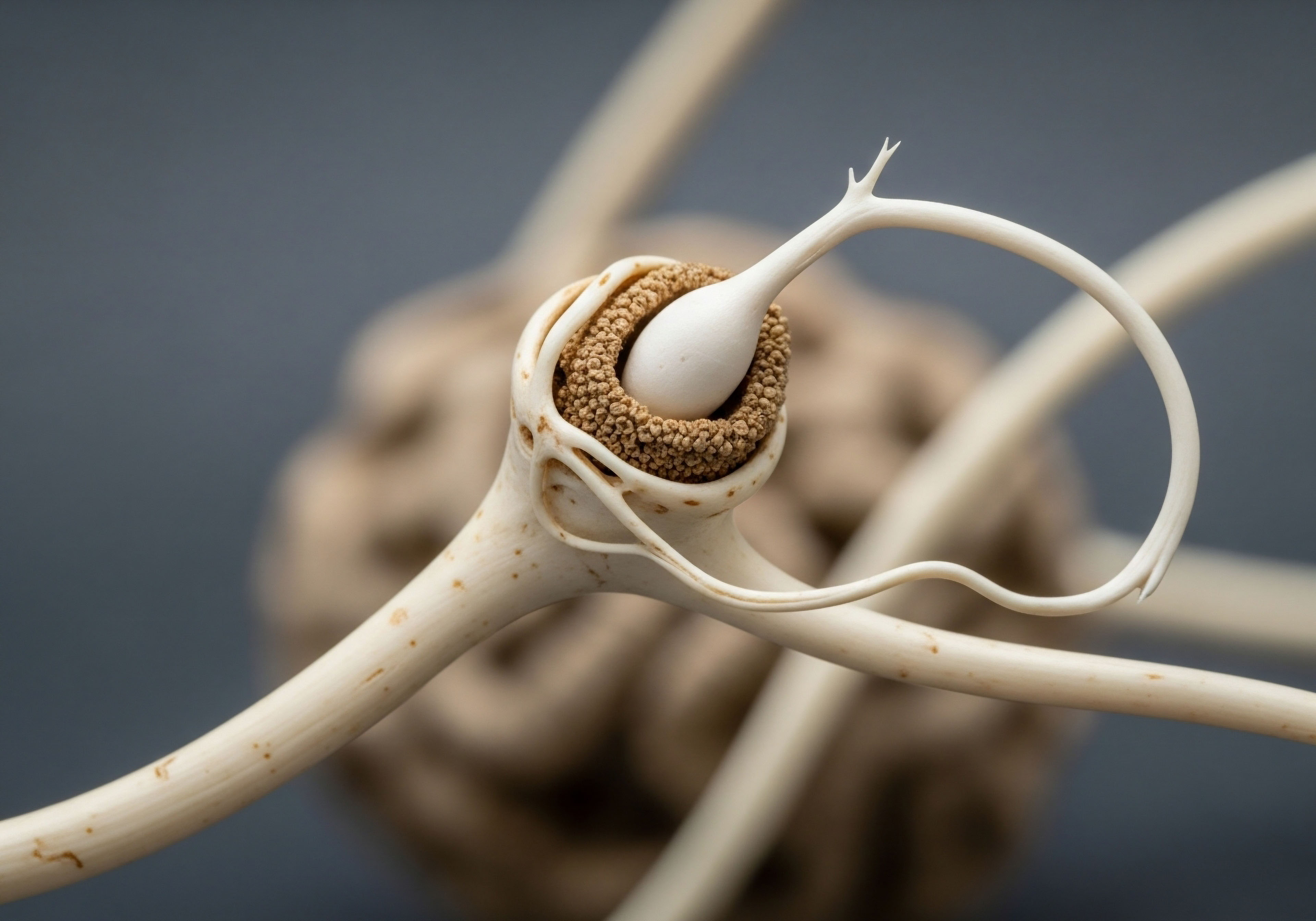

Your Plateaus Are a Failure of the Mind Not the Muscle
You have followed the protocols with perfect execution. Your nutrition is dialed in to the gram, your sleep is a non-negotiable eight-hour sanctuary, and your training split is a model of periodized precision. Yet, the numbers on the bar have stalled. The reflection in the mirror shows a physique that has stopped evolving.
The familiar narrative suggests you have hit a genetic ceiling, that your muscles have given all they can. This narrative is incomplete. The ceiling you feel is a construct of your own internal wiring. The silent killer of your progress, the invisible governor on your strength and size, is your nervous system.
Every contraction, every lift, every single expression of physical force begins as an electrical signal in the brain. Your muscles are simply the hardware, powerful yet inert without the sophisticated software of the central nervous system (CNS) to command them. The initial, often explosive, strength gains experienced by any novice lifter are almost entirely a neurological event.
The body is not building significant new muscle tissue in the first few weeks. Instead, the brain is learning to use the hardware it already possesses with greater efficiency. It is optimizing its command signals, a process of neuromuscular adaptation that unlocks latent potential.
The nervous system acts as a protective brake, limiting how much muscle you can voluntarily activate to prevent self-inflicted injury.
This same system designed for efficiency also possesses a powerful self-preservation protocol. Your CNS actively inhibits the full force-producing capacity of your muscles. This neural inhibition is a biological safeguard, a pre-programmed brake designed to protect tendons, ligaments, and the muscle tissue itself from tearing under extreme exertion.
Your body intentionally limits your output because it does not yet trust its own structural integrity to handle the force you are demanding. The plateau you are experiencing is this safety mechanism in full effect. It is a signal that your software, not your hardware, requires the upgrade. To build a new physique, you must first remap the neurological pathways that govern it.


Recalibrating the System for Limitless Progress
Accessing the next level of physical development requires a direct intervention at the level of the nervous system. This is a process of systematic recalibration, turning down the protective inhibition and turning up the high-performance signaling. It involves training the brain and the nerves with the same intention and precision applied to training the muscles.
The goal is to re-engineer the body’s internal communication architecture, transforming it from a system governed by safety to one designed for superior output. This is achieved through a multi-pronged approach targeting every layer of the neuromuscular hierarchy.

The Architecture of Strength beyond Muscle Fiber
True strength is the efficient transmission of force, a conversation between your brain and your muscles. This conversation happens across a network of motor units. A motor unit is composed of a single motor neuron and all the muscle fibers it innervates.
When your brain decides to lift a weight, it sends a signal down the spinal cord to these motor neurons. Some motor units control slow-twitch fibers, built for endurance. Others command the powerful, fast-twitch fibers responsible for explosive strength and possessing the greatest potential for growth.
A beginner’s nervous system is inefficient, recruiting only a fraction of available motor units and often calling on them in a disorganized fashion. An elite lifter’s nervous system is a master conductor, recruiting a vast number of motor units, particularly the high-threshold, fast-twitch units, and firing them in perfect synchrony to produce immense force. The objective is to upgrade your internal operating system to achieve that same level of flawless execution.

Technique One Mastering Motor Unit Recruitment
Your first protocol is to teach your brain to recruit more motor units. This is the foundation of neurological strength. Greater recruitment translates directly to more muscle fibers contracting simultaneously, which means more force produced during a lift. The primary stimulus for recruiting the highest-threshold motor units is load and intent.
Lifting heavy, near-maximal weights forces the CNS to call upon its most powerful fibers out of necessity. Similarly, moving a sub-maximal weight with maximal velocity, as in explosive training or plyometrics, achieves the same end. The intent to be fast and powerful refines the brain’s ability to activate these fibers on command.
This process enhances intermuscular coordination, which is the synchronized action of different muscle groups working together to execute a complex movement like a squat or deadlift with precision and power.

Technique Two Increasing Firing Rate
Once motor units are recruited, the force they produce is modulated by their firing rate, a process called rate coding. Think of it as the RPM of your muscular engine. A higher firing frequency from the motor neuron causes the muscle fibers to contract more forcefully and rapidly.
You can have two individuals with identical muscle mass, but the one with a superior ability for rate coding will be demonstrably stronger. Training this quality involves a focus on dynamic, forceful movements. After a period of heavy lifting enhances recruitment, incorporating phases of speed work can train the nervous system to increase the frequency of the signals it sends.
This is one reason why experienced athletes appear so smooth and explosive; their nervous systems are not just recruiting muscle, they are making that muscle fire at an incredible speed.

Technique Three the Mind Muscle Connection as a Command Line
The concept of the “mind-muscle connection” is the conscious, deliberate focus on the specific muscle being worked during an exercise. This is a direct application of internal attention to enhance neurological output. Studies using electromyography (EMG) confirm that actively thinking about the target muscle increases its electrical activity, leading to superior activation and, over time, enhanced growth.
This is your tool for writing precise code for your body. Instead of just moving a weight from point A to point B, you are directing the neurological impulse with surgical accuracy.
- For Compound Lifts (Squats, Deadlifts) ∞ The focus is external. Concentrate on the explosive act of driving the floor away or pulling the bar apart. This broad cue helps the CNS coordinate multiple muscle groups effectively.
- For Isolation Movements (Curls, Extensions) ∞ The focus is internal. Actively visualize and feel the target muscle contracting and lengthening through its entire range of motion. Slowing the eccentric (lowering) phase of the lift is particularly effective for this, as it increases the duration of the signal and enhances the connection.
- The Paused Repetition ∞ Incorporating a distinct pause at the point of peak contraction in a movement (e.g. at the top of a row or the bottom of a squat) forces the nervous system to maintain maximal signaling without the assistance of momentum. This builds immense control and strengthens the neural pathway.

Technique Four Overcoming Neural Inhibition
Your final and most advanced task is to strategically recalibrate the nervous system’s protective brakes. You must convince your brain that your body is robust enough to handle higher levels of force. This is done by exposing it to controlled stimuli that exceed its normal capacity.
Eccentric training, or focusing on the negative portion of a lift, is a powerful tool for this. You can handle significantly more weight eccentrically than concentrically, and this overload sends a potent signal to the CNS that the tissues are strong. This stimulus, combined with stretch under load, is a primary driver of hypertrophy.
Visualization is another key protocol. Mentally rehearsing a successful lift with perfect form primes the neural pathways for success, making the actual execution more efficient and confident. Finally, strategic deloads or periods of reduced intensity are essential. They allow the nervous system, which fatigues just like muscles, to recover and supercompensate, returning stronger and more efficient than before.


Activating the Protocol and Witnessing the Results
The decision to shift focus from a purely muscle-centric view to a neuro-centric one becomes relevant at two critical junctures in your training career. The first is during the initial months of training. Understanding that the rapid surge in strength is a neurological phenomenon allows you to capitalize on it.
By incorporating varied movements and focusing on technical perfection, you build a broad and efficient neural foundation that will support muscular growth for years to come. The second, and more common, juncture is the moment of the dreaded plateau.
When you have been training diligently for years and find your progress has ground to a halt despite optimized recovery and nutrition, that is the definitive signal. It is the moment to audit your neurological output and deploy the protocols to upgrade it.
The feedback from this recalibration is both immediate and profound. The first indication is subjective. Weights that previously felt like maximal efforts begin to feel lighter and more manageable in your hands. You will notice a new level of crispness and control in your movements.
The bar path on your bench press will feel more stable; you will feel more rooted and powerful at the bottom of a squat. This is the sensation of improved motor unit recruitment and synchronization. You are expressing force with less internal resistance. The objective results follow shortly after.
You will see progress on your main lifts begin to tick upward again, breaking through previous personal records. This is not because you have built pounds of new muscle overnight. It is because you have unlocked the performance potential of the muscle you already carry.
Initial strength gains from a new training program are largely due to adaptations within the nervous system, not immediate muscle growth.
The timeline for these adaptations is encouragingly rapid. Significant improvements in neural drive and motor control can manifest within a few training cycles, often in as little as three to six weeks. This is the short-term payoff that provides the motivation to continue. The long-term result is a new trajectory of growth.
By enhancing the quality of the signal from your brain to your muscles, you create a more potent stimulus for hypertrophy with every single rep. You are no longer just lifting weights; you are conducting a precise dialogue with your own biology, a dialogue that commands adaptation and growth.

The Body Obeys the Signals It Is Given
Your physical form is a direct manifestation of the information it receives. For too long, the conversation around physical development has been confined to the muscular and the metabolic. It is a limited dialect that fails to acknowledge the master controller, the central command that dictates every outcome.
To view your body as a system of levers and pulleys is to miss the ghost in the machine. To understand that the nervous system is the ultimate arbiter of your physical potential is to gain access to an entirely new control panel.
The architecture of your body is not fixed; it is perpetually responding to the quality of the signals you send it. The question is no longer about how hard you can train your muscles. The question is how clearly you can command them.

Glossary

nervous system

neuromuscular adaptation

fast-twitch fibers

rate coding

mind-muscle connection

eccentric training

motor unit recruitment




